|
by Dr. Kristin K. Burton-Hall, VMD 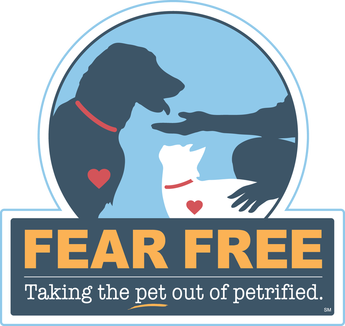 sIf you have visited GVVH recently you may have been surprised as we offered your pet peanut butter, cheese, canned chicken or canned food. This is part of a new certification we have achieved called Fear Free. Fear Free is an initiative developed by Dr. Marty Becker aimed at using gentle control techniques and calming environments in the veterinary hospital to make veterinary visit easier on the pet and owner. The Fear Free initiative involves much more than simply feeding your pet while he/she is here for an exam. Every member of our staff has completed nine hours of continuing education and training to become certified. Our goal is to make the visit as stress free as possible on your pet. We want them (and you!) to like coming to the veterinarian. Puppyhood and kittenhood are the most crucial times to begin your pet's veterinary health care in a fear free environment. We are striving toward more and more to use food, praise, petting and toys as a distraction from the unpleasant but necessary poking and prodding that we must do to them to keep them healthy. We are also trying to exam your pet in an setting that is less intimidating for him/her. Every pet is an individual and we may need a few tries to learn what works best. For cats this may mean removing the top of the carrier and letting him/her sit in the bottom for most of the exam. Some cats feel safer in a familiar area. For dogs this may mean doing most of the exam with him/her on the floor and only using the exam table briefly to obtain a body weight. 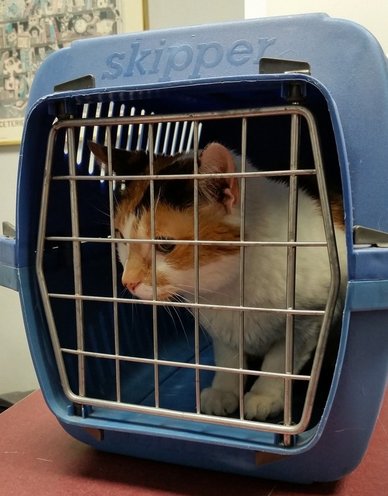 What you can do to help: For cats- Make the carrier a more pleasant place to be. Many owners make the mistake of keeping the carrier hidden away and only bring it out when the cat is going to come to the vet. The cat quickly learns to associate the carrier with a scary car ride and trip to the dreaded vet’s office. Leave the carrier out in your home, occasionally putting food and treats in the carrier as well as a comfortable blanket so that your kitty can go in and out of the carrier as he/she pleases. Practice putting kitty into the carrier closing the door and letting them right back out, then give a tasty treat such as canned food or tuna. This way on the day of your schedule visit it won’t be such a struggle to get your kitty into the carrier. When transporting the carrier do not use the handle. Carry it by the bottom as if you would as fragile gift. Carrying it by the handle, swings kitty causing increased movement and nausea. When placing the carrier in the car, put it on the floor of the backseat, behind the passenger seat, this will also decrease movement of the car moving and keep the car from sliding around on the seat or off the seat. This is the safest place for kitty should you have the extreme misfortune of being involved in an accident with kitty in the car. Keep the carrier covered with a towel and once in the veterinary clinic do not set the carrier of the floor. Cats like to be up high. Being on the floor provides too much frightening stimuli: stamping feet, grabbing hands, and sniffing noses of other pets in the clinic. Bring your kitty while they're hungry. Withhold food for 4-6 hours prior to the appointment. This will make your cat less likely to because nauseated and vomit on the way to the clinic and also make them more interested in any food we may offer during the appointment. Talk with us about any concerns you have; you know your feline friend better than anyone else. There are safe, mild sedatives available to help if you think your pet needs it. For some cats and their owners these are a life saver! For others the stress of trying to give the medication at home before the visit far outweighs any benefits. Some cats may be do worse if food is withheld prior to the appointment. Let us know what you think worked well or didn’t work well at his/her last appointment. The synthetic feline facial pheromone "Feliway" is very calming to some cats but not others. It is available in our clinic via diffuser in our exam rooms. You may also request a towel with Feliway prayed onto it to see if your pet could benefit from pheromones. 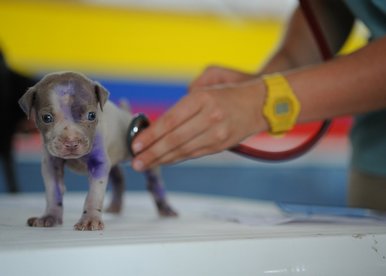 For Dogs- Bring your dog hungry. Similarly to our feline friends above, withholding food for 4-6 hours prior to the appointment will make your dog less likely to because nauseated and vomit on the way to the clinic. It can also make them more interested in any food we may offer during the appointment. Dogs tend to eat the tasty treats we offer much better for us than cats do. If your dog is not highly food motivated bringing his/her favorite toy can also be very helpful. We have several dogs who are very happy to hold their ball during their vet visits. Teach your pet to accept handling. This is especially helpful for your puppies. Work with your dog to get them to tolerate you opening his/her mouth, look at his/her ears, play with his/her feet all the while treating and rewarding your pet for tolerating and accepting the handling. There should not be any part of your pet’s body that you can not touch. This will make them much more accepting of the handling they must undergo at the hospital. Talk with us about any concerns you may have. Very stressed or nervous dogs can benefit greatly from having a sedative or anti-anxiety medication given at home prior to the appointment. Let us know if this is something you think your pet would benefit from. Also let us know what worked or didn’t work at the last appointment: Does he/she do better if the exam is done with them on the floor? Does a non-slip mat help? Does your pet do better if he/she waits in the car until we are ready? Our goal as always is to provide the best care possible this includes providing you and your pet as stress-free visit as possible. For more information visit the Fear Free website.
6 Comments
by Dr. S. Dawn Dinger, DVM 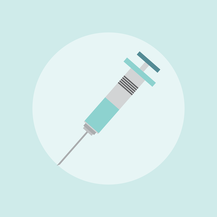 Vaccinations are one of the best ways to help keep your pet healthy and living a long and happy life. There are many different vaccines that protect against a multitude of different diseases which can affect both your pet and you. Recently though there have been some questions about how often to vaccinate and even what vaccines to give. In part I of this this blog, we'll answer some of the common questions about vaccinations. In parts II and III we'll cover the most current vaccine recommendations for both dogs and cats and talk about what diseases they protect against. 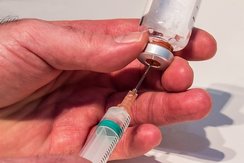 What is a vaccine? Vaccines are substances given to stimulate the immune system. They are usually given by injection, but there are some oral (by mouth) and intranasal (by nostril) vaccines as well. Vaccines contain “antigens” which are designed to look like the disease they are protecting against and which stimulate the production of “antibodies” - small proteins which fight specific infections. This way, if the dog or cat is ever exposed to the real disease, their body is already prepared to fight off the infection. I've heard about core and non-core vaccines. What does that mean? These are terms used by the latest American Animal Hospital Association (AAHA) and American Association of Feline Practitioners (AAFP) vaccination guidelines. In general, “core” vaccinations are those that are considered vital for every pet due to how common the disease is, the risk of exposure, the severity of the disease or the risk to people. These include diseases such as Distemper and Parvo virus for dogs; Panleukopenia and Rhinotracheitis for cats; and Rabies for both species. “Non-core” vaccines are ones that your pet may or may not need depending on their lifestyle and risk of exposure. This does not necessarily mean that the diseases are less severe. Non-core vaccines include diseases such as Bordetella (Kennel Cough) and Feline Leukemia. At Green Valley Veterinary Hospital we will discuss vaccinations for your pet at each wellness visit to help determine what is needed to keep your pet safe. 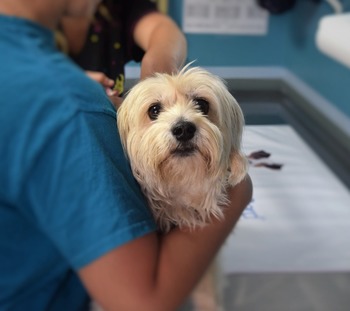 Are any vaccinations required by law? Typically rabies vaccinations are required by law for dogs and cats over 12 weeks of age in the United States, however individual states may have different requirements as to how often those vaccinations need to be given (IE every year vs every 3 years). How often does my puppy or kitten need to be vaccinated and when do we start? Puppies and kittens receive some antibodies from their mother while nursing (assuming she was properly vaccinated herself). These help protect them from disease while they are very young, however the strength of those antibodies wanes with time. To compensate for this and the fact that young animal's immune systems are still maturing, vaccinations are typically started around 6-8 weeks of age and are continued every 3-4 weeks until they are 16-20 weeks of age. What about my adult dog or cat? The vaccination schedule for adult animals depends on the type of vaccine given, the disease we are protecting against, your pet's overall health and previous vaccination history. Some vaccines may need to be given annually, while others might only need to be given every three years. We will work with you to determine the best vaccination schedule for your pet. Are there any risks? Countless animals have been saved by vaccination so the benefits definitely outweigh the risks. However as with any medical procedure, there is always a small chance of side effects. With the vaccinations available today however, in most cases these risks are quite small compared to the disease itself. 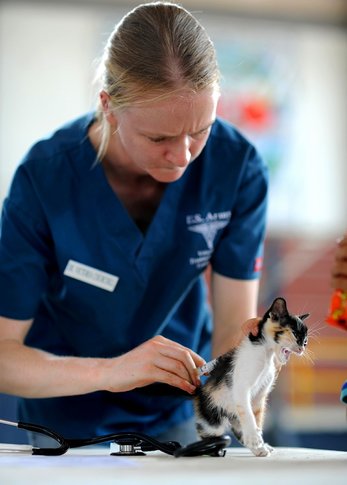 What signs should I watch for? Vaccines stimulate the immune system. It is not uncommon for there to be some mild soreness at the site where the vaccine was given (just like us when we get a vaccine), but a low grade fever or even allergic reactions can develop less commonly. Some signs that warrant veterinary attention include: severe lethargy, vomiting, diarrhea, facial swelling, hives, pallor (looking pale in hairless areas or gums) and collapse. What are Vaccine Associated Sarcomas in cats? A sarcoma is a type of cancer. Most sarcomas that occur are not related to vaccines at all, but some tumors have occurred at the site of vaccinations with Rabies and Feline Leukemia being the most commonly implicated. Most veterinary scientists believe the culprit is the “adjuvant” in those vaccinations (an adjuvant is a substance that is added to some vaccines to stimulate a stronger immune response and prolong the vaccine's action) and so current recommendations are to only administer “non-adjuvanted” vaccines to cats. Rest assured that at Green Valley Veterinary Hospital we only administer the safest vaccinations available to our feline patients. Fortunately vaccine associated sarcomas are quite rare, only occurring between 1 in 1000 to 1 in 10,000 vaccinations. Can I buy and administer vaccinations at home for my pet? The short answer to this question is yes (except for Rabies which by law has to be administered by a licensed veterinarian), but it is not recommended for several reasons. One, vaccines need to be shipped and stored at the proper temperature to maintain their sterility and effectiveness. This can not be guaranteed when purchasing vaccines at the pet or feed store for example. Also vaccinations need to be administered appropriately and in the locations recommended in the current guidelines which can sometimes be difficult without appropriate training and restraint. In addition, syringes and needles are considered medical waste and can not be legally disposed of in the regular trash, and in the event that your pet does develop a problem secondary to the vaccination, you may not be quipped to manage it. Most importantly though is the fact that there is much more to your pet's annual visit that just “shots”. A complete, comprehensive physical exam is the most important part of your pet's visit to the veterinarian, but that visit also includes assessment of and recommedations on things like behavior, diet, parasite control and diagnostic testing, as well as an assessment of risk so the correct vaccinations themselves can be selected. In Part II of this blog, we will discuss the current canine vaccination guidelines and the various disease we are trying to prevent so stay tuned…. |
AuthorsDr. S. Dawn Dinger, DVM Archives
May 2017
Categories |
 RSS Feed
RSS Feed